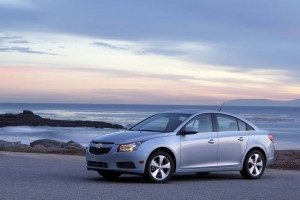Already a year late to market, Chevrolet has a lot riding on its new Cruze sedan, the much-needed replacement for its dated Cobalt model.
A year after it emerged from Chapter 11 protection, General Motors is struggling to stabilize its market share, even though it now has half the number of brands to compete with in North America after abandoning Saab, Saturn, Hummer and Pontiac as part of its court-ordered reorganization. That means the maker can no longer pick and choose the segments it competes in. It has to take on rivals like Toyota at every opportunity.
“This is as important a launch as we’ve ever had at Chevrolet,” says Alan Batey, Vice President – Chevrolet Sales and Service.
Initial reviews are coming in quite positive (Click Here for TheDetroitBureau’s first drive of the 2011 Chevrolet Cruze.) But in today’s market, that may not be good enough. While GM’s overall market share hovers just below 20%, the figure collapses when you focus on the coasts. On Long Island, for example, GM isn’t even in double digits. And it’s not doing much better on the other side of the country. In California, while GM has a reasonable stake in the light truck market, its passenger cars are virtually invisible.
Establishing Cruze as a credible offering will be critical to re-establishing Chevrolet as a viable alternative in the passenger car market, according to Margaret Brooks, who serves as marketing director for Chevy’s small car line-up.
The Cruze, however, is just one of several new offerings with which Chevrolet hopes to assault the Japanese head-on. It’s also launching several smaller models, such as the Korean-made Spark, and the next-generation Aveo.
While Chevy officials downplay any effort to take advantage of their rivals current misfortunes, they’re quietly hoping that Toyota has provided them an opportunity to gain some ground, what with its ongoing recall problems. There are indications this may be happening. The latest data from the research firm, Experian Automotive, shows Toyota losing momentum, even as Detroit makers gain steam.
But the big winner, at the moment, is Ford Motor Co., which has surged to the top of the charts, both in terms of quality, reliability and overall consumer attitudes. Consumer surveys show that Ford has clearly benefited from its decision not to accept a federal bailout, last year, while the same data show that many consumers are consciously avoiding GM because it took government aid.
But despite such concerns, there are definite upward signs. The Chevrolet Equinox is a prime example. The new model is commanding an average $3,400 higher transaction price than the crossover utility vehicle it replaced, notes Chevy General Manager Jim Campbell. And that’s when a customer can get one. Currently, there’s barely a 20-day supply of the CUVs on dealer lots, barely a third what the industry considers the norm.
The new Camaro and the midsize Malibu sedan are also faring well, according to recent sales charts.
The Chevrolet brand accounts for more than two-thirds of overall GM sales, after the bankruptcy and elimination of four brands, so, “As goes Chevrolet, so goes General Motors,” says Campbell.
But sales alone aren’t the sole indicator of a turnaround. The brand faces several challenges. First, it has to draw in buyers who will be trading in Pontiacs, Saturns and Saabs. But, longer-term, a revival of the Chevy brand – which once commanded more than a third of the overall American market – will depend on “conquesting” its competition. And preliminary signs suggest that its newest models are pulling in a growing number of Japanese trade-ins.
Chevy hopes as many as half of all new Cruze buyers will be conquests. It’s a tough goal, but a critical one. There simply aren’t enough old Cobalt buyers to generate the necessary momentum for the new compact sedan.
But getting there won’t be easy. It will require, among other things, one of the more expensive ad campaigns in Chevy history. Launching an all-new model is extremely costly, a major national campaign running as much as $50 million more than for an established product, according to ad industry experts. The challenge – and cost – grows exponentially when you’re targeting segments where you’re not especially well-known. Now add Chevy’s need to re-establish itself on the East and West coasts.
The debut of Cruze will prove a test not only for the brand itself but for GM’s new marketing chief, Joel Ewaniak, and for the division’s new advertising team. It won’t be cheap, nor will it be easy. But succeeding with Cruze could be the breakthrough that Chevrolet desperately needs.


If you believe WSJ, the Cruze is already dead!